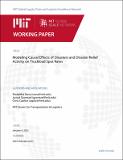Modeling Causal Effects of Disasters and Disaster Relief Activity on Truckload Spot Rates
Author(s)
Rana, Shraddha; Goentzel, Jarrod; Caplice, Chris
DownloadFull report (1.495Mb)
Metadata
Show full item recordAbstract
Freight transportation is an important part of the US economy, of which 60% is movement of goods by trucks. We are particularly interested in full truckloads that move goods for a single customer, from a single origin to a single destination. During disasters, as the demand for truckload transportation increases to stock up and distribute emergency supplies, the ability decreases due to infrastructure damage. The increase in demand is not only from private sector but more importantly from public sector agencies for disaster relief. Moreover, as the public and private sector shippers compete for the same carrier resources, it can result in constrained truckload availability and consequently higher prices. With the increase in frequency of natural disasters it is important to model historical impact in order to be prepared for truckload procurement for future disasters. We contribute to disaster modeling and management literature by measuring causal effects of disasters on a critical system's performance. We quantify the magnitude, geographical spread, timing, and duration of the causal effects of disaster conditions (Hurricane Harvey and Hurricane Irma) and consequent public sector disaster relief activity on private sector truckload spot rates using a difference-in-differences methodology. We find that long-haul loads inbound to nodes near the hurricane's paths are most affected by both disaster conditions and disaster relief activity, experiencing a large magnitude of statistically significant increase in spot rates during hurricane periods. Moreover, the increase in spot rates is both localized and short-lived.
Date issued
2024-01-04Series/Report no.
SCALE Working Paper Series;2024-mitscale-ctl-01
Keywords
difference-in-differences, causal inference, disaster relief distribution, freight transportation, truckload spot rates